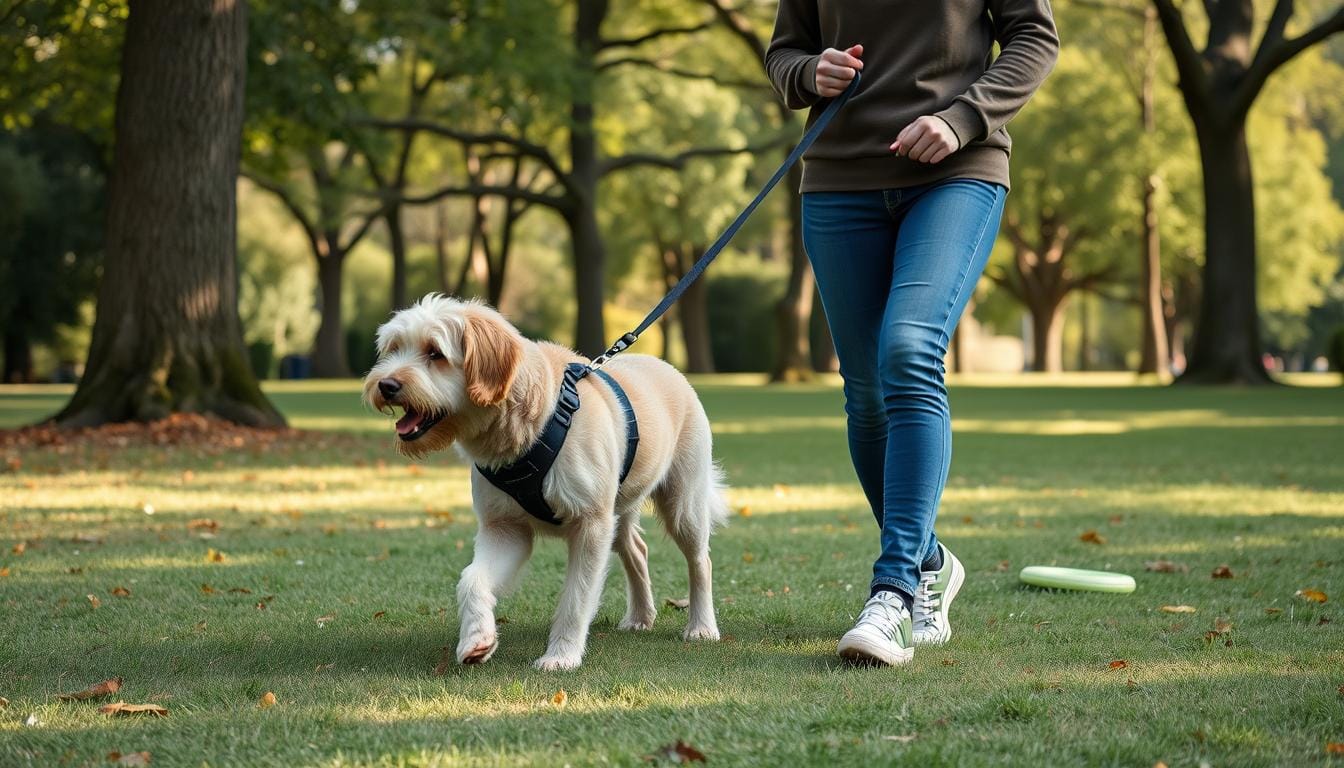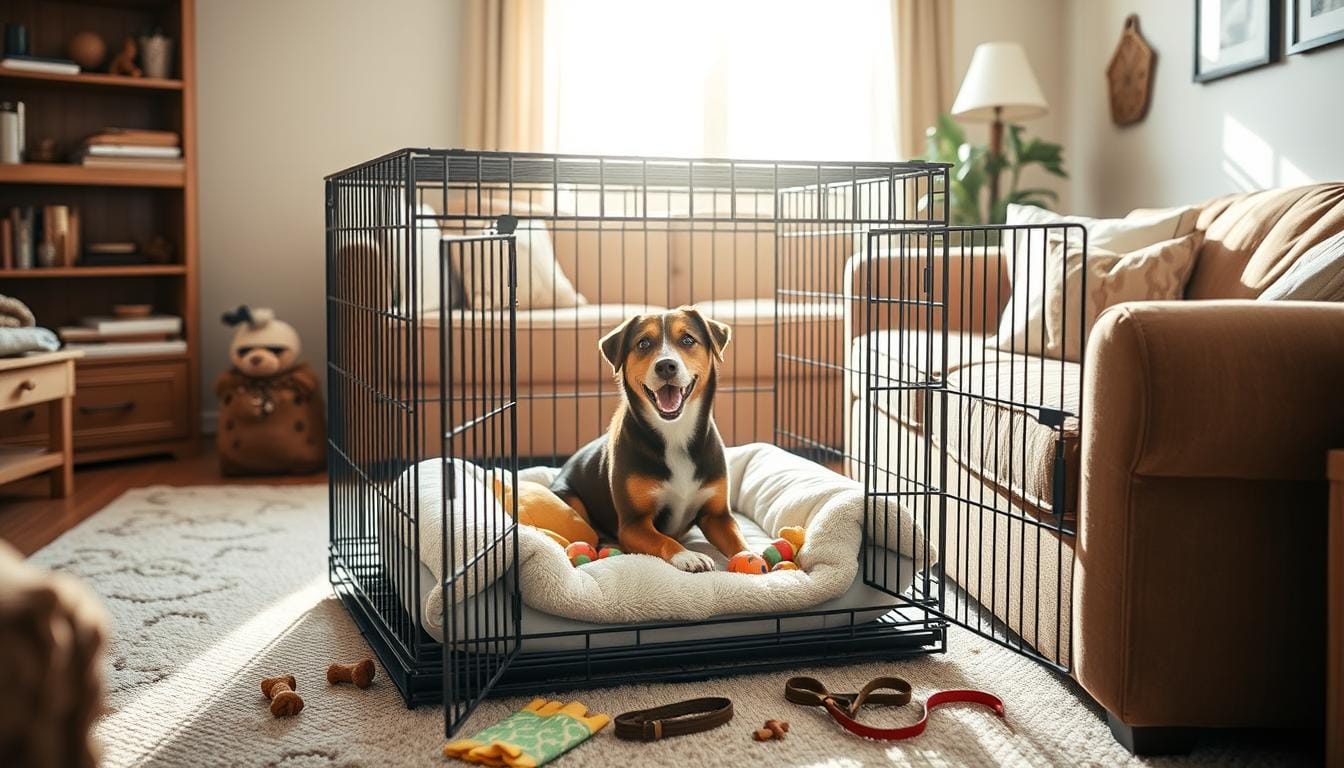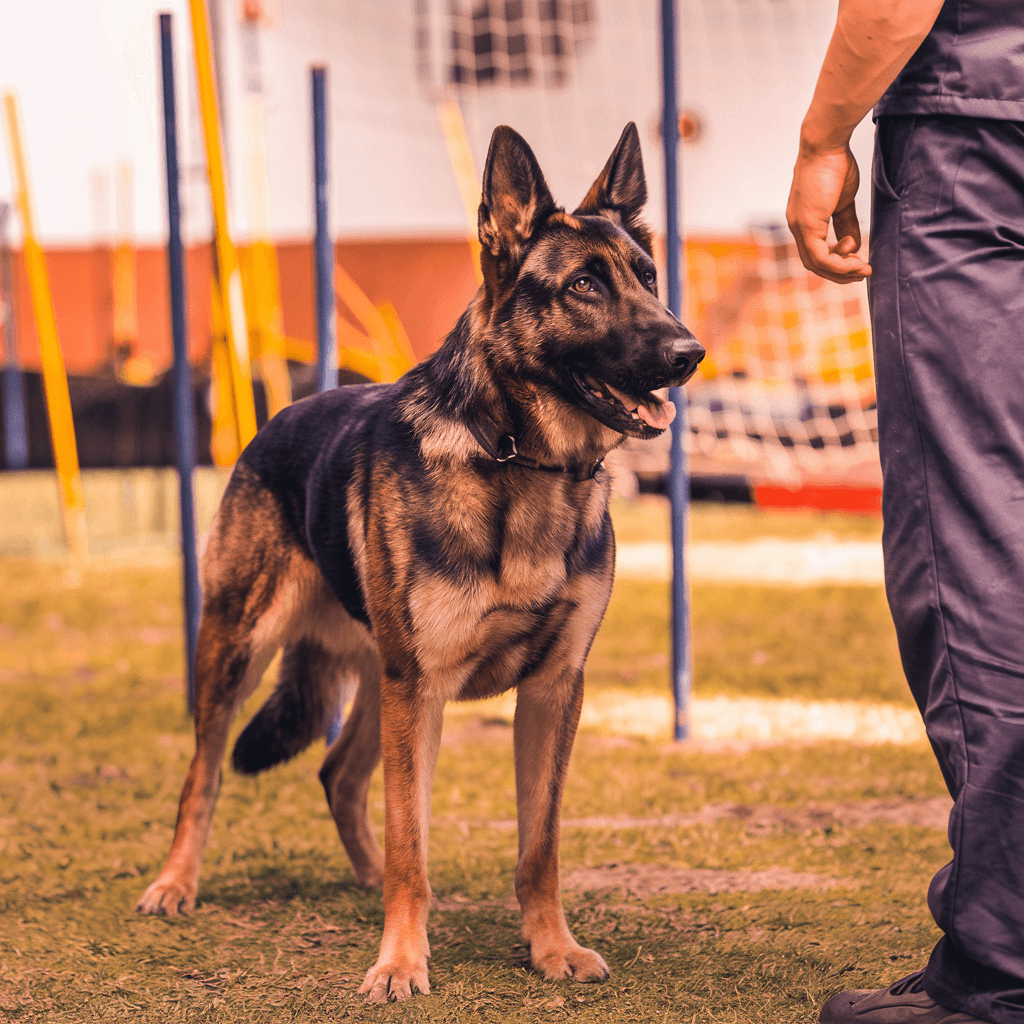Dogs can sense human emotions instinctively. They are experts at reading our facial expressions and body language. This shows the deep bond we share with them. Let’s explore how to brush your dog’s teeth, a key part of dog dental care.
Keeping your dog’s teeth clean is crucial for their health. Over 80% of dogs over three years old have periodontal disease. Regular brushing can stop plaque buildup, which causes bad breath and gum disease.
We’ll show you how to start a tooth brushing routine for your dog. By following our steps, you’ll be ready to take care of your dog’s teeth. Let’s make sure your dog’s smile stays bright and healthy!
Key Takeaways
- Daily brushing is ideal, but even three times a week can make a difference
- Use dog-specific toothbrushes and toothpaste for safe and effective cleaning
- Establish a positive routine to make tooth brushing enjoyable for your dog
- Focus on small areas at a time, gradually increasing coverage
- Complement brushing with dental chews and regular vet check-ups
- Plaque can harden into tartar in less than 36 hours if not removed
- Aim for brief, consistent brushing sessions lasting about 30 seconds
The Importance of Canine Dental Care
Keeping your dog’s teeth clean is vital for their health. Many pet owners forget about dog health dental care. But, ignoring it can lead to serious problems.
Preventing plaque is crucial for your dog’s mouth health. Plaque turns into tartar, causing gum disease if not stopped. Brushing regularly removes plaque, keeping your dog’s teeth and gums in good shape.
- By age 3, over 80% of dogs show signs of dental disease
- Periodontal disease is graded on a scale from 0 (normal) to 4 (severe)
- About 80% of dogs will allow teeth brushing if introduced gradually
These stats show why starting dental care early is key. Ignoring oral hygiene can cause more than bad breath. It can lead to tooth loss, pain, and even harm to organs as bacteria spread through the blood.
| Age | Percentage of Dogs with Dental Issues | Recommended Care |
|---|---|---|
| 3 years | 80% | Regular brushing, dental chews |
| Adult | 85-90% | Daily brushing, annual professional cleaning |
| Senior | 90-95% | Daily brushing, more frequent vet check-ups |
By making dental care a regular part of your routine, you can avoid many problems. This way, your dog can keep a healthy smile for a long time.
Gathering the Right Dental Tools for Your Dog
Keeping your dog’s teeth clean is key for their health. We’ll show you how to pick the best tools for their dental care. The right tools make brushing easier and more effective.
Choosing the Right Toothbrush
A good dog toothbrush is crucial for cleaning. Look for soft bristles to protect your dog’s gums. There are several types to choose from:
- Long-handled brushes for larger dogs
- Finger brushes for small dogs and puppies
- Dual-ended brushes for versatility
Choose a brush size that fits comfortably in your dog’s mouth. Avoid stiff bristles or large heads that might cause discomfort.
Selecting Dog-Friendly Toothpaste
Never use human toothpaste for your dog. Pet toothpaste comes in flavors dogs love, like chicken, beef, or peanut butter. Enzymatic toothpastes are popular as they help break down plaque. Choose a non-toxic, fluoride-free option, especially for puppies.
Additional Dental Care Products
While brushing is key, other products can support your dog’s oral health:
- Dental chews for plaque reduction
- Oral rinses for fresh breath
- Dental wipes for quick cleanings
Remember, these items supplement brushing, not replace it. Regular brushing remains the gold standard for canine dental care.
| Tool | Best For | Features |
|---|---|---|
| Long-handled brush | Large dogs | Easy reach, multiple angles |
| Finger brush | Small dogs, puppies | Gentle, precise control |
| Enzymatic toothpaste | All dogs | Plaque-fighting enzymes |
| Dental chews | Supplementary care | Helps reduce tartar buildup |

With these tools, you’re ready to start a dental care routine that will keep your dog’s teeth healthy and breath fresh. Regular brushing, combined with professional check-ups, forms the foundation of excellent canine oral health.
Preparing Your Dog for Teeth Brushing
Starting a dental care routine for your dog needs patience and preparation. Begin this when your dog is still a puppy. This early start helps build a positive association with teeth brushing.
To start your dog’s dental care, pick a quiet spot in your home. For smaller breeds, hold them in your lap. Larger dogs can sit beside you while you’re in a chair. This makes them comfortable and helps you control during brushing.
Introduce your pet to teeth brushing slowly. Start by rubbing their teeth with your finger or a soft cloth. Use a back-and-forth motion, focusing on where the gum meets the tooth. This helps your dog get used to the feeling.
As you train your dog for dental care, increase the time of these sessions. Start with a few seconds a day, then gradually increase it. Remember, patience is key in this process.
| Dog Size | Recommended Starting Position | Initial Duration |
|---|---|---|
| Small | In lap, facing away | 5-10 seconds |
| Large | Beside you, while seated | 10-15 seconds |
By following these steps, you’re setting a solid foundation for your dog’s dental health. With consistent effort, your pet will soon see teeth brushing as a normal part of their routine.
Creating a Positive Brushing Environment
A good brushing experience is vital for your dog’s dental health. We’ll look at how to make teeth cleaning a positive part of your dog’s routine.
Choosing the Right Time and Place
Find a quiet spot in your home where your dog feels at ease. Choose a time when your dog is relaxed, like after a walk or play. Being consistent helps your dog know when it’s time to brush.
Using Rewards and Positive Reinforcement
Positive reinforcement is key for a good brushing experience. Use dog treats and praise to reward your dog. This helps your dog see brushing as a positive thing.
Start with short, fun sessions, especially when beginning. As your dog gets used to it, you can make the sessions longer. The goal is to make brushing a fun time for both of you.
| Brushing Frequency | Benefits | Recommended Approach |
|---|---|---|
| Daily | Optimal plaque prevention | Use positive reinforcement and dog treats |
| Twice daily | Best for maintaining dental health | Incorporate into morning and evening routines |
| Weekly | Minimal protection against dental disease | Supplement with dental chews and toys |
By making the environment positive and using rewards, your dog will see brushing as a nice activity. This is the start of a lifetime of good dental health for your dog.
How to Brush Dog Teeth: The Proper Technique
Learning the right way to brush your dog’s teeth is key for their oral health. We’ll show you how to brush correctly. This ensures you cover all parts of your pet’s mouth.
First, gently lift your dog’s lips to see the teeth. Use a soft-bristled toothbrush made for dogs and a bit of toothpaste safe for pets. Hold the brush at a 45-degree angle to clean the gum line and remove plaque.
Start brushing in small circles, focusing on the teeth’s outer surfaces. Use light pressure to avoid hurting your dog. Brush for about 30 seconds on each side, covering both top and bottom teeth.
Here’s a breakdown of the brushing process:
| Area | Technique | Duration |
|---|---|---|
| Front teeth | Gentle circular motions | 30 seconds |
| Canines | Up-and-down strokes | 20 seconds |
| Back teeth | Small circles and horizontal strokes | 40 seconds |
| Gum line | Angle brush at 45 degrees | 30 seconds |
Take short breaks and give treats to keep your dog relaxed. With time, this routine will become second nature. It will make your pet healthier and happier.
Gradually Introducing the Toothbrush and Toothpaste
Teaching your dog to use dental products needs patience and a slow start. Up to 90% of dogs suffer from periodontal disease. So, it’s vital to introduce dental care early.
Familiarizing Your Dog with the Toothbrush
Getting your dog used to the toothbrush is the first step. Start by placing the toothbrush near their toys or food. This helps them see it as a positive thing.
Then, gently touch their face with the brush. Reward them for staying calm. This makes the toothbrush a normal part of their life.

Introducing Dog-Friendly Toothpaste
Introducing toothpaste should be fun for your dog. Begin by letting them taste a small amount on your finger. If they like it, try putting a tiny bit on their teeth.
Be consistent. Aim for this 2-3 times a week at first.
| Step | Duration | Frequency |
|---|---|---|
| Toothbrush familiarization | 1-2 minutes | Daily |
| Toothpaste introduction | 30 seconds | 2-3 times per week |
| Combined brush and paste | 1-2 minutes | 2-3 times per week |
By following these steps, you’re building a strong dental care routine for your dog. Just under 2 minutes a day can greatly improve their oral health.
Mastering the Brushing Motion
Getting good at brushing your dog’s teeth is essential for their gum health. Begin with soft, circular strokes on the outer teeth surfaces. This area tends to collect plaque, so focus here. Start with a few teeth and gradually add more as your dog gets used to it.
To remove plaque well, hold the brush at a 45-degree angle to the gumline. Brush for about a minute, splitting the time between the top and bottom teeth. Brushing regularly is key. Brush your dog’s teeth at least three times a week to keep their mouth healthy.
Seeing a bit of bleeding when you start is normal. It’s a sign their gums are getting used to the brushing. But, if the bleeding doesn’t stop or gets heavy, it might mean gum disease or too much brushing. If this happens, see your vet right away.
| Brushing Element | Recommendation |
|---|---|
| Brush Angle | 45 degrees to gumline |
| Brushing Time | About 1 minute total |
| Frequency | At least 3 times per week |
| Target Area | Gingival sulcus (3mm space between teeth and gums) |
Learning this brushing technique is a big step in keeping your dog’s teeth and gums healthy. Be patient and keep at it. It’s important for a good dental care routine for your dog.
Brushing Different Areas of Your Dog’s Mouth
Knowing about dog mouth anatomy is key for good dental care. We’ll show you how to brush your dog’s teeth well to keep them clean and healthy.
Focusing on the Outer Surfaces
Begin by brushing the outer surfaces of your dog’s teeth. This area gets a lot of plaque, especially near the gums. Use gentle, circular motions to clean each tooth, focusing on canines and back molars. Over 80% of dogs over three years old get periodontal disease, making this step very important.
Addressing the Canine and Back Teeth
Canine and back teeth need extra care. They get tartar fast. Use short, back-and-forth strokes on each tooth. Try to brush for about 30 seconds on each side of your dog’s mouth. Even if you can’t reach the inner surfaces, your dog’s tongue helps keep them clean.
Here are some dental care tips to improve your brushing routine:
- Use a dog-specific toothbrush with soft bristles
- Apply pet-friendly toothpaste in appealing flavors
- Focus on the gum line to prevent periodontal disease
- Brush at least three times a week, ideally daily
By following these steps and keeping up a regular routine, you can prevent dental problems and keep your dog’s mouth healthy. Remember, being patient and using positive reinforcement are crucial for your dog’s dental care.
Establishing a Regular Brushing Routine
Daily dental care is key for your furry friend’s health. Brushing their teeth fights bad breath and boosts their overall health. Try to brush at least three times a week, but daily is best.
Plaque can harden on your dog’s teeth in just 24 hours. So, keeping up with oral hygiene is vital. Choose a time that fits you and your pup, making it easier to stick to it. It might take a few weeks to get to a full two-minute brushing, so be patient.
Getting the whole family involved can make it more enjoyable. Use treats to make brushing a positive experience. If you see heavy bleeding, it might be gum disease, so see your vet. Regular brushing and vet visits are essential for your pet’s dental health.
















